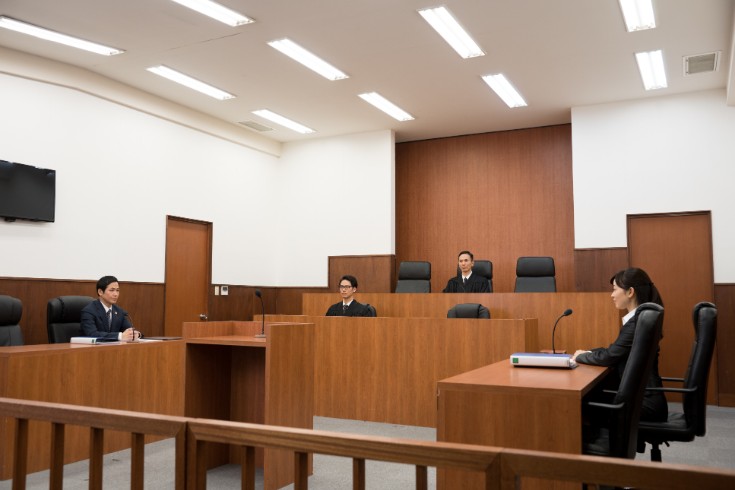Resolving Disputes through the Courts under Japanese Labor Law: Understanding as a Business Strategy

In corporate management, disputes with employees are an unavoidable management risk. However, these disputes are not merely legal issues; the resolution process itself can have a significant strategic impact on a company’s finances, reputation, and organizational culture. The choice of resolution procedure a company makes when a dispute arises is a critical management decision that affects cost, time, and the ultimate outcome. The Japanese judicial system offers multiple procedures for resolving labor-related disputes, each with its own unique personalityistics and strategic implications. Specifically, these include the “Labor Tribunal Procedure” aimed at swift resolution, the “Civil Litigation” for thoroughly contesting rights, the “Preservation Litigation” for emergency responses at the onset of disputes, and the “Summary Court Litigation” and “Civil Conciliation” specialized for monetary claims. These procedures are not just a list of options but strategic tools to be utilized according to the situation. This article aims to provide practical guidance for maximizing corporate interests and minimizing damages by deeply analyzing the personalityistics of these judicial procedures from a managerial perspective. Understanding not only the legal framework of each procedure but also the underlying dynamics, risks, and opportunities is the first step in effectively managing the crisis of disputes.
Labor Tribunal Procedures in Japan: Emphasizing Swift and Practical Resolutions
The Nature of Labor Tribunal Proceedings Under Japanese Law
Labor tribunal proceedings in Japan are specialized judicial procedures designed to resolve civil disputes between individual workers and employers, such as the validity of dismissals or the payment of unpaid wages, in a swift and practical manner. The most distinctive feature of these proceedings lies in their adjudicative structure. The hearings are conducted by a ‘Labor Tribunal Committee,’ which consists of one professional judge, known as a labor tribunal judge, and two lay judges with specialized knowledge and experience in labor relations. This tripartite composition ensures that decisions are made not only from a purely legal standpoint but also incorporate practical perspectives such as employment practices and the realities of the workplace. This structure clearly demonstrates the nature of the proceedings, which aim for realistic and fair resolutions over the formal establishment of rights and obligations.
The Procedure Flow from the Company’s Perspective Under Japanese Labor Tribunal Practices
For companies, labor tribunal proceedings in Japan progress extremely swiftly, and initial responses significantly influence subsequent developments.
Typically, a company first becomes aware of a legal dispute when it receives a “summons” and a “petition” detailing the worker’s claims from the court. From the time of this notification, there is a very short period, generally within 40 days, until the first hearing.
Within this limited timeframe, the company must prepare a “response” that articulates a detailed counterargument to the worker’s claims and submit it to the court along with supporting evidence by the deadline set by the tribunal. Facing a well-prepared petition from the worker’s side, the company must construct its rebuttal within a few weeks, an overwhelmingly short preparation period that poses the greatest challenge for the company.
The first hearing is not merely a procedural confirmation; the Labor Tribunal Committee conducts direct and intensive questioning of the company’s representatives and managers to clarify the issues at stake. In many cases, the committee forms an overall picture and a provisional assessment (tentative evaluation of the case) at this initial hearing, which greatly influences subsequent mediation negotiations. Approaching the first hearing unprepared can make it exceedingly difficult to overturn an unfavorable situation.
The labor tribunal procedure aims to conclude the examination within three hearings as a general rule. The focus of the procedure is on resolution through discussions between the parties, namely the establishment of “mediation.” In fact, about 70% of labor tribunal cases are resolved through this mediation. Only if mediation fails does the Labor Tribunal Committee issue a “judgment” based on the actual circumstances of the case. However, if either party objects to this judgment within two weeks of receiving notice, the judgment loses its effect, and the procedure automatically transitions to a regular civil lawsuit.
Strategic Implications in Management
Labor tribunal proceedings in Japan carry clear benefits for companies, as well as equally significant risks.
Among the benefits, the first to note is their speed. The average duration of a case is about 3 months (80 to 90 days), which, compared to civil litigation that can often extend beyond a year, allows for the minimization of wasted management resources such as time, costs, and human resources. Secondly, the confidentiality of the proceedings effectively protects the company’s reputation and prevents secondary damages such as employee unrest or media coverage. Thirdly, due to the lower court fees compared to litigation and the shorter duration of the proceedings, there is a potential to control the total costs, including attorney fees.
On the other hand, the risks are serious. The biggest disadvantage, as mentioned earlier, is the extremely short preparation period. This can place the company at a disadvantage without sufficient opportunity to prepare its defense. Additionally, since the entire process is strongly oriented towards resolution through mediation, there may be strong pressure to agree to a settlement involving certain concessions, even when there is a legally valid claim, due to unfavorable impressions suggested by the committee. Furthermore, given that Japanese labor laws inherently favor worker protection and labor tribunals prioritize practical resolutions over strict legal interpretation, the outcomes tend to be harsher for companies.
The essence of this procedure should be understood as a highly pressured negotiation conducted under the powerful authority of the Labor Tribunal Committee, while taking the form of a judicial proceeding. The goal for companies is not to “win” in court, but to use legal claims as a tool for negotiation and to reach a settlement under the most favorable conditions possible. Therefore, the initial response document submitted is not merely a legal text but plays a crucial role as an opening statement in this short-term battle of negotiations.
While the non-public nature of the proceedings is a significant advantage in protecting the company’s reputation, it requires strategic caution. The employee side may recognize that the company wants to avoid a public court dispute and use this as leverage in negotiations. In other words, they may apply unspoken pressure by threatening to object to the tribunal and shift to public litigation if their demands are not met. Consequently, the corporate strategy should be to resolve disputes within the framework of the labor tribunal. To achieve this, from the early stages of the proceedings, it is essential to present compelling arguments and evidence that demonstrate readiness to fight effectively even if the case moves to litigation, convincing both the committee and the opposing party that it is wiser to seek a reasonable resolution at this stage rather than moving to litigation.
Civil Ordinary Proceedings: The Ultimate Measure to Thoroughly Contest Rights Relations Under Japanese Law
The Nature of Ordinary Civil Litigation in Japan
Ordinary civil litigation is a traditional and formal judicial procedure selected when other processes, such as labor tribunals, cannot resolve a dispute or when the nature of the case initially demands a stringent judgment in court. If an objection is raised against the judgment of a labor tribunal, the procedure automatically transitions to ordinary civil litigation. This process is personalityized by an adversarial structure where both parties repeatedly present their legal arguments through documents called “preparatory briefs” and rigorously prove the legitimacy of their claims based on evidence. The goal is not to achieve a flexible resolution that conforms to the actual situation but to determine the rights and obligations based on law and evidence.
Procedures and Trial Periods Under Japanese Law
Litigation procedures in Japan commence when the plaintiff (usually an employee) files a “complaint” with either the district court or the summary court, depending on the amount claimed. Subsequently, the parties engage in several months, and sometimes over a year, of exchanging multiple written preparatory documents. Court sessions are regularly held primarily to review the content of the submitted documents and to discuss preparations for the next steps.
In cases where there is a dispute over the facts, unlike labor tribunals, formal proceedings called “witness examinations” are conducted to hear directly from the parties themselves and related individuals, and to verify evidence. These witness examinations are critical moments that can influence the outcome of the judgment.
After the conclusion of the trial, the court will issue a “judgment.” The Japanese judicial system adopts a three-tiered system, allowing parties dissatisfied with the first-instance judgment to “appeal” to the high court and further “appeal to the Supreme Court.” As a result, it can take several years to obtain a final and conclusive judgment. However, at any stage of the litigation, it is possible to resolve disputes through a “court settlement” mediated by a judge, and in practice, many cases are concluded through settlements.
Strategic Implications in Management
Ordinary civil litigation represents a procedure with personalityistics that are the polar opposite of labor tribunals for companies in Japan.
Its greatest advantage lies in the ample preparation time it affords. The extended period of trial allows companies to devise intricate legal defense strategies, gather extensive evidence, and fully present their arguments, providing them with the luxury of time. Moreover, as the proceedings are based on strict legal interpretation and precedents, companies with strong legal grounds stand a higher chance of securing a favorable judgment.
However, the disadvantages are quite severe. Firstly, the resolution process is exceedingly lengthy. Even the first instance alone requires an average of more than one year of trial, and if the case progresses to appeals or higher courts, the final settlement could be years away. This binds the attention and time of the management over an extended period, posing a significant burden on the company. Secondly, the costs can be exorbitant. As the trial drags on, legal fees skyrocket. Thirdly, and most importantly from a managerial perspective, the proceedings are generally public. This can lead to the dispute’s details becoming public knowledge, potentially damaging the company’s brand image and social credibility if reported in the media. Internally, it may also cause anxiety and distrust among other employees, negatively impacting the overall morale of the organization. Lastly, due to the nature of the procedure which involves thorough contention, the conflict between the parties becomes definitive, and even if an employee wins the case and is reinstated, establishing a good employment relationship thereafter is almost impossible.
Therefore, ordinary civil litigation is often the last resort chosen as a result of failed attempts at earlier negotiations or labor tribunals. The high costs, lengthy duration, and the risks associated with public disclosure make it an unattractive option for both parties. The strategic value of this procedure for a company does not necessarily lie in ‘winning’ the case but rather in demonstrating a resolute stance that they are prepared to fight to the end, despite the costs and risks. This credible threat can be a powerful bargaining chip during the private negotiation stages of a labor tribunal, deterring the opposing party from making excessive demands and leading to a settlement at a more realistic level of compensation. Companies that show a willingness to avoid litigation at any cost lose significant leverage in the early stages of negotiation.
Strategic Comparison of Labor Tribunal and Civil Litigation Procedures in Japan
When a company faces a labor dispute in Japan, understanding the fundamental differences between labor tribunal procedures and civil litigation from a strategic perspective is essential in deciding which procedure to choose or prepare for.
The most notable difference is the time required for resolution. Under the labor tribunal system, the goal is to conclude the proceedings within an average of about three months, typically within three sessions. In contrast, civil litigation often takes at least one to two years, or even longer, for the first instance alone, making the prolongation of disputes inevitable.
This difference in time directly affects the cost aspect. Labor tribunal fees are set at about half of those for litigation, and due to the shorter trial period, attorney fees tend to be lower compared to litigation. On the other hand, civil litigation can result in significantly higher legal fees due to its prolonged nature.
Crucially important for corporate reputation management is the public nature of the proceedings. Labor tribunals are conducted in private, minimizing the risk of the dispute becoming known externally. Conversely, civil litigation is generally conducted in open court as required by the constitution, allowing anyone to attend, which poses a significant reputational risk for companies.
The methods of examination also differ significantly. Labor tribunals focus on direct oral questioning by the Labor Tribunal Committee, aiming for a flexible resolution (settlement) through dialogue. Civil litigation, however, centers on the submission of written arguments and evidence, a more formal and strict procedure.
The entities making the decisions also differ. In labor tribunals, a committee consisting of one judge and two experts with practical experience from both labor and management sides makes the decisions, whereas in civil litigation, professional judges alone are responsible for the proceedings.
Finally, the systems for contesting decisions differ. In labor tribunals, a simple “objection” can be filed to express dissatisfaction, automatically transitioning the case to civil litigation. Civil litigation judgments, however, are subject to more complex and formal appeal procedures such as “appeals” and “petitions for review.”
The following table summarizes these differences. It can help determine which procedure aligns with a company’s strategic goals (e.g., swift and confidential resolution or thorough assertion of principles) in a specific dispute situation.
| Labor Tribunal Procedure | Civil Litigation | |
| Resolution Period | Swift (Average about 3 months) | Long-term (Over 1 year) |
| Cost | Relatively Low | Relatively High |
| Public Nature of Proceedings | Private | Generally Public |
| Decision-Making Body | Labor Tribunal Committee (1 Judge, 2 Experts) | Judge |
| Main Examination Method | Oral Questioning, Dialogue-Centered | Written Arguments & Evidence-Centered |
| Contesting Decisions | Objection Leading to Litigation | Appeal & Petition for Review |
Preservation Litigation: Emergency Response in the Early Stages of Disputes in Japan
The Nature of Preservation Litigation (Provisional Dispositions) Under Japanese Law
Preservation litigation, particularly the ‘provisional disposition’ used in labor disputes, is an urgent procedure where the court orders temporary measures in cases where waiting for the final judgment of a full-scale lawsuit (main action) could result in irreparable harm. Its purpose, in the early stages of a dispute, is to temporarily protect the rights of workers. In labor disputes, it is primarily used by dismissed workers to secure their status and income.
Typically, there are two main types of provisional dispositions, which are often filed simultaneously:
- Status Preservation Provisional Disposition: An order confirming that a worker temporarily retains their status as an employee.
- Wage Advance Provisional Disposition: An order for a company to continue paying wages to a worker during the pendency of the main action lawsuit.
Significant Risks for Management
Due to their urgent nature, provisional disposition proceedings progress extremely quickly. The first hearing date can be set within 1 to 2 weeks of filing, and it is not uncommon for the court to make a decision within 3 to 6 months. To obtain a court decision in this procedure, workers must demonstrate two requirements: the existence of a ‘right to be preserved’ (e.g., the right to claim wages based on an employment contract) and the ‘necessity of preservation’ (e.g., the need to avoid irreparable harm such as financial ruin if wages are not paid).
The greatest risk for companies arises when a wage advance provisional disposition is granted, resulting in an asymmetric financial burden. Based on the court’s order, the company must continue to pay wages to a worker who is not working. The most critical point is that these payments, by their nature of being allocated to the worker’s living expenses, can be difficult to reclaim later, even if the company wins the main action lawsuit. Furthermore, workers often obtain these provisional disposition orders with no or low security at the discretion of the court. This mechanism creates a situation where the company’s financial losses continue to increase unilaterally as long as the dispute persists, exerting strong pressure on the company to settle early.
Defensive Strategies for Companies
For companies faced with a provisional disposition application, the most effective defense strategy is to thoroughly attack the ‘necessity of preservation’ claimed by the worker. Specifically, they argue, with objective evidence and circumstances, that the worker in question will not immediately fall into financial hardship without the advance payment of wages.
The specific points of contention that companies should argue include:
- The worker has sufficient savings or assets.
- There are other stable sources of income, such as a spouse’s income or side jobs.
- The worker has already secured a new job and income.
Of course, in parallel, it is also important to argue the legality of the company’s actions, such as the justification for dismissal, and to question the very existence of the ‘right to be preserved’ claimed by the worker.
This procedure uses time and financial pressure as a weapon against companies. It has the effect of transferring the economic burden from the worker to the company at the very initial stage of the dispute. The situation is created where the company’s sunk costs increase every month as the court orders the payment of wages that are effectively non-recoverable, fundamentally altering the dynamics of negotiation. The issue is no longer just about the amount of future settlement money but about how quickly the ongoing financial outflow can be stopped, becoming an urgent management issue. Therefore, a swift and strong rebuttal against the application for provisional disposition itself, and rejecting it at the initial stage, becomes the top priority to avoid a prolonged war of attrition.
Small Claims and Civil Conciliation: Simplified Options for Financial Disputes in Japan
Small Claims Procedure
The Small Claims Procedure is an extremely simple and swift legal process available exclusively for claims demanding payment of up to 600,000 yen (approximately $4,500 USD). The hallmark of this procedure is that, in principle, the case is examined and a judgment is rendered on the same day, typically after just one hearing. Therefore, parties must prepare all their arguments and evidence in advance and submit them to the court by the hearing date.
From a business management perspective, this procedure could be utilized, for example, in cases of small unpaid wage claims from former employees. A company that becomes a defendant has the option to request a transfer to regular civil litigation if the case is complex. However, the greatest risk for the company in a Small Claims Procedure is its ‘one-time’ nature. Unlike regular litigation, there is no option to appeal to a higher court. The only recourse is to file an “objection” with the same summary court that issued the judgment. The decision following the objection is final and carries the force of enforceable execution.
Civil Conciliation
Civil Conciliation is a procedure where a conciliation committee, composed of judges and knowledgeable civilians, intervenes neutrally between the parties to facilitate a voluntary resolution through discussion. This process is optional and cannot succeed unless both parties are willing to negotiate and make concessions. The proceedings are private, aiming for a flexible resolution that prioritizes the satisfaction of both parties over strict application of the law, and is more in line with the actual circumstances.
As a strategic business decision, civil conciliation can be an effective option when the conflict between parties is not too severe, when maintaining future relations is desirable, or when non-monetary issues such as workplace environment adjustments are at stake rather than monetary claims. However, if one party remains intransigent, the conciliation may fail, potentially wasting time and effort.
These simplified procedures should be seen as specialized tools for specific situations due to their nature. The monetary limit of the Small Claims Procedure (600,000 yen) and the non-binding nature of Civil Conciliation are not suitable for resolving serious labor disputes that affect the core of a company, such as the validity of dismissals or high-value unpaid wage claims. Disputes over dismissals often involve back pay amounts well over 600,000 yen, and the gap between the parties’ claims is usually too wide for resolution through voluntary conciliation. Therefore, management should consider these procedures as means to efficiently handle relatively minor, purely financial disputes, and not as a primary strategy for significant labor disputes.
Understanding the Reality of Labor Disputes Through Japanese Case Law
To grasp how various procedures actually function in disputes and the outcomes they produce, it is essential to examine specific case law. Below, we will explain the judgments rendered by Japanese courts and their strategic implications for three typical types of disputes that particularly impact corporate management.
Unfair Dismissal
The Bloomberg L.P. case (Tokyo District Court, October 5, 2012) involved a company that dismissed an employee due to alleged deficiencies in communication skills, and the speed, quantity, and quality of work not meeting the required standards. However, the court deemed this dismissal invalid.
The managerial lesson from this ruling is that merely claiming “inadequacy” or “poor performance” is insufficient to justify a dismissal. The courts impose extremely stringent requirements on companies before recognizing the most severe disadvantageous treatment for workers, such as dismissal, as valid. Specifically, companies must 1) concretely prove the fact of inadequacy based on objective and rational criteria, and 2) demonstrate that they provided the employee with sufficient guidance, training, or opportunities for improvement, such as reassignment, to avoid dismissal. The presence of detailed records of these processes in objective evidence (evaluation records, guidance records, emails, etc.) becomes a decisive factor in the success or failure of the company’s claims.
Unpaid Overtime
In the Kosho Industry case (Kagoshima District Court, February 16, 2010), an employee who was the manager of a restaurant claimed unpaid overtime wages. The company argued that the employee was a managerial supervisor and therefore not entitled to overtime pay, but the court rejected this claim and ordered the company to pay approximately 7.32 million yen.
This case serves as a warning against the so-called “manager in name only” issue. To treat an employee as a “managerial supervisor” under the Japanese Labor Standards Act, it is insufficient to merely assign a managerial title. The court rigorously examines the reality of the situation, such as 1) whether the employee is involved in decision-making on management policies, 2) whether they have discretion over their own working hours without strict control, and 3) whether they receive treatment (wages, etc.) commensurate with their position. Inadequate attendance management or ambiguous employment contracts can later rebound on the company as a serious financial risk in the form of substantial unpaid overtime claims, as this judgment clearly demonstrates.
Power Harassment
In a ruling by the Fukui District Court on November 28, 2014, the court recognized the responsibility of both the company and a supervisor for the suicide of a new employee who had been subjected to persistent verbal abuse (such as “You should just die”). The court ordered a high compensation payment of approximately 73 million yen.
This judgment highlights the gravity of the “duty of care” that companies bear. Companies have a legal obligation to maintain an environment where employees can work safely, both physically and mentally, and neglecting harassment in the workplace is considered a violation of this duty. This case indicates that harassment is not merely an individual issue but a significant management risk that the entire organization must address. The establishment of effective anti-harassment policies, regular training for all employees, and the creation of a safe and accessible reporting system, followed by appropriate investigation and response processes, are essential to prevent such tragedies and the accompanying catastrophic management damage.
Summary
The Japanese judicial system offers a variety of options for resolving labor disputes, each with its own purpose and function. If a swift and confidential resolution is a priority, the “Labor Tribunal Procedure” can be an effective choice, but its short preparation period may pose a significant risk for companies. On the other hand, if a company wishes to assert its legal legitimacy thoroughly, “Civil Litigation” provides the stage, but one must be prepared for the serious trade-offs of prolonged duration, high costs, and the reputational risks associated with public proceedings. Additionally, “Preservation Litigation” can impose unilateral financial burdens on a company at the early stages of a dispute, requiring rapid and accurate defense. “Summary Court Proceedings” and “Civil Conciliation” are limited tools for handling smaller monetary disputes. The optimal strategy varies greatly depending on the specific facts of each case and what the company prioritizes most (speed, cost, confidentiality, or adherence to principles). A deep understanding of these procedures and making the best choice according to the situation is key to effectively managing the crisis of a dispute.
Monolith Law Office boasts a wealth of experience acting as a representative for companies in all these judicial procedures. Our strength lies not only in our deep expertise in Japanese labor law but also in the fact that we have several English-speaking attorneys with foreign legal qualifications on our team. This allows us to deeply understand the unique cultures and management perspectives of companies that operate internationally and to provide seamless and sophisticated legal services in both Japanese and English. When faced with the complex challenge of labor disputes, please consult with us. As your strategic partner, we are committed to protecting your interests to the fullest and guiding you to the best resolution.
Category: General Corporate





















